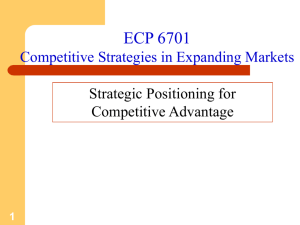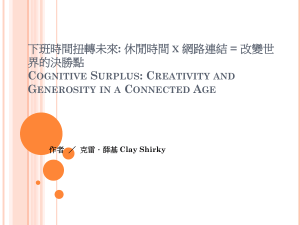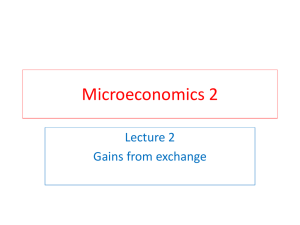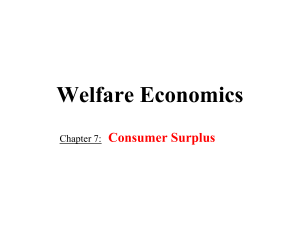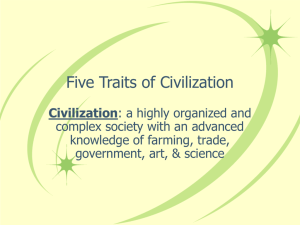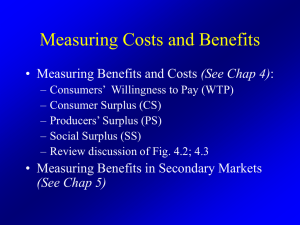Strategic Positioning for Competitive Advantage
advertisement
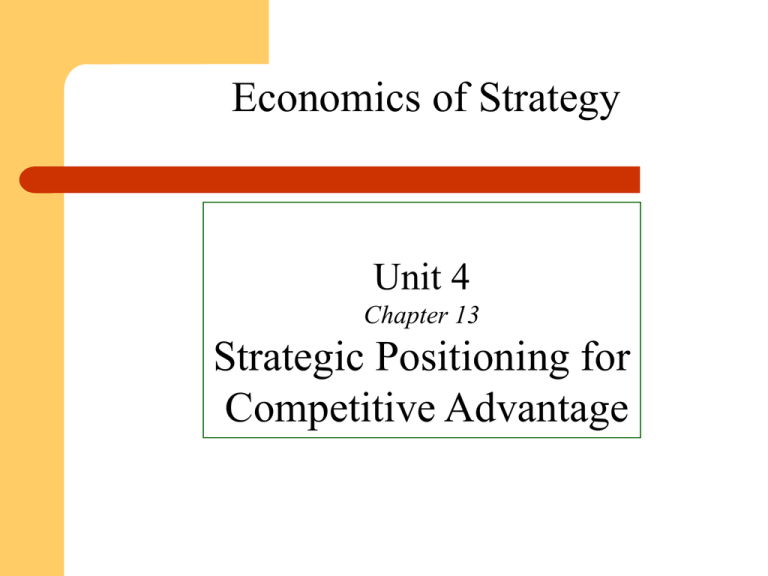
Economics of Strategy Unit 4 Chapter 13 Strategic Positioning for Competitive Advantage Whole Foods Market, Inc case No class Wed, Oct 26 Whole Foods Preliminary Case: Wed, Nov 2 Final case: Monday, Nov 7 Source: http://www.wholefoodsmarket.com/company/ Strategic Positioning Firms within the same industry can position themselves in different ways Not all positions will be equally profitable or lead to the same odds of survival Why do profits vary across firms? A firm’s ability to create value and enjoy a competitive advantage over other firms depends on how it positions itself within its industry Competitive Advantage and Value Creation A firm is said to have a competitive advantage in a market if it earns a higher rate of economic profit compared to the average economic profit in the industry Economic profit earned by a firm depends on the market conditions as well as the economic value created by the firm Competitive Advantage and Value Creation A firm can achieve competitive advantage only if it can create more economic value than its competitors A firm’s ability to create value depends on its cost position as well as its benefit position relative to its competitors Framework for Competitive Advantage Value Leadership Strategy Benefit leaders – – – – – – Woodford Reserve Coca Cola Fresh Market Stores Godiva Chocolates Dean Foods Nest Fresh Eggs Cost leaders – – – – – – Jim Beam Big K Cola (pvt labels) Save-A-Lot Hersheys Kroger/Aldi Cal Maine, pvt label Value Creation and Profitability Value created = consumer surplus + producer’s profit Consumer surplus is the difference between the maximum the consumer is willing to pay (monetary value of the perceived benefit) and the price Components of Consumer Surplus A firm can increase consumer surplus by increasing the perceived benefit or by selling at a lower price The firm can also increase consumer surplus by reducing the cost of using the product and the transactions costs that the consumer incurs Competition in Price-Quality Continuum When products differ in quality, competing firms can be viewed as submitting consumer surplus bids with their quality-price combinations When a firm fails to offer as much consumer surplus as its rivals, its sales will decline “preferred supplier” criteria Example of Coffee Brands Kroger Brand Nescafe instant Maxwell House, Folgers Millstone Dunkin Donuts Starbucks Kona ……many other products with variable prices and quality – wine, beer, cheese, meat, dining menus The Value Map P, Price Lower consumer Product D surplus Product B Product A indifference curve Product C Higher consumer surplus q, quality Value Map: An Illustration Points on the indifference curve represent price-quality with the same consumer surplus The steepness of the indifference curve reflects the tradeoff between price and quality that the consumers are willing to make Value Map: An Illustration Products A and B exhibit consumer surplus parity Product C has a higher consumer surplus than A and B Product D has a lower consumer surplus Value Created and Economic Profits Value created = Consumer surplus + Producer surplus = (B - P) + (P - C) =B-C If (B-C) is not positive the product offers no competitive advantage. Value Created and Competitive Advantage To achieve competitive advantage, a firm must produce more value than its rivals Consumers will demand the same consumer surplus from the firm as from its rivals With superior value creation, the firm can offer as much consumer surplus as the rivals and still make an economic profit Consonance Analysis of Value Creation Consonance (harmony, agreement) analysis looks at a firm’s prospects for continuing to create value Ability to create value will be affected by – – – – changes in market demand changes in technology and threats from other firms in the industry and from other industries Quality of supply chain relationships The Value Chain The value chain or the vertical chain is the representation of the firm as a set of value creating activities Activities in the value chain include primary activities like production and marketing as well as support activities such as human resource management and finance Value Creation and Resources and Capabilities Two ways in which a firm can create more economic value than its competitors – – Configure its value chain differently from competitors Perform the activities more effectively than the rivals If the firm’s value chain is similar to its rivals’ the firm needs resources and capabilities that the rivals do not have to create superior value LEAN Manufacturing (Toyota) 1 The seven wastes – – – – – – – 1.1 Overproduction 1.2 Unnecessary transportation 1.3 Inventory 1.4 Motion 1.5 Defects 1.6 Over-Processing 1.7 Waiting Value Creation and Resources and Capabilities Capabilities have some of the following characteristics – – – They are typically valuable across multiple markets and products They are embedded in organizational routines that survive when individuals are replaced They represent tacit knowledge in the organization Strategic Positioning Two broad approaches to strategic positioning – – Cost leadership Benefit leadership Alternative is to use a narrow focus strategy The Strategic Logic of Cost Leadership A cost leader can create more value than its competitors by – offering the same benefits as the competitors do (benefit parity)…at a lower cost – – Private label mustard offering a slightly lower benefit (benefit proximity) offering a qualitatively different product Cubic zirconium vs diamonds 100% Kona Kona “Blend” The Strategic Logic of Benefit Leadership A benefit leader firm can create superior values by offering – – – cost parity cost proximity substantially higher benefit and higher cost Still need isolating mechanisms that keep firms from quick benefit duplication Marksbury Farms Products Exploiting a Competitive Advantage Through Pricing When the product differentiation is weak (small opportunity to be a benefit leader) the firm should follow a market share strategy With a cost advantage, the firm should under price its rivals and build share With a benefit advantage, the firm should maintain price parity and let the benefit build the share (rather than building share through lower cost) Exploiting a Competitive Advantage Through Pricing When the product differentiation is strong the firm should follow a profit margin strategy (max gross margin) With a cost advantage, the firm should maintain price parity with its rivals With a benefit advantage, the firm should charge a price premium over the competitors Search goods vs experience goods Search goods – objective quality attributes can largely be assessed by the typical buyer prior to the point of purchase (photo services, commodity products) Experience goods – quality can only be assessed after the consumer has purchased it and used it for awhile (electronics, wine, appliances, education, medical service – movies, plays, music, concerts…..,apple picking?) Conditions Suitable for Seeking a Cost Advantage Cost advantage should be sought – – – when the nature of the product does not allow benefit enhancement (commodity characteristics) when consumers are relatively price sensitive and when the product is a search good rather than an experience good Conditions Suitable for Seeking a Benefit Advantage Benefit advantage should be sought – – – when consumers are willing to pay a premium for benefit enhancements when economies of scale and learning have been already exploited and differentiation is the best route to value creation and when the product is an experience good Diversity of Strategies Firms need to deliver a distinct bundle of economic value through their strategy choices When consumers differ in their willingness to pay for product attributes, different strategies can coexist – but tough to manage “Stuck in the Middle” It can be argued that firms should either pursue a cost advantage or a benefit advantage but not both Firms that pursue both could, according to this argument, get stuck in the middle and have neither advantage In reality, successful firms appear to have both types of advantages simultaneously Cost and Benefit Leadership Learning economies may be more important for high quality production than for low quality production The high quality producers may also be more efficient producers than low quality producers Strategic Positioning Two specific strategy questions are important – – How will the firm create value? [Benefit, cost] Where will the firm do it? [Broad or narrow segments] Segmenting an Industry An industry can be represented in two dimensions – Product varieties – families of related products – Customer groups Snack foods LOHAS A potential segment is the intersection of a particular product group with a particular customer group Segmenting with a market-customer diagram Product Possibilities Customer Groups ……… ……… Extension Possibilities for Pumpkins Customer Groups Families State Parks Restaurants Selected Age Groups Geographic markets Homeowners Schools.... Product Possibilities Pumpkins Miniature pumpkins Gourds Miniature hay bales Mums Halloween ensembles.... Segmenting an Industry Differences in segments arise due to – – – Customer preferences Supply conditions Segment size Customers within a group should have common features Broad Coverage Strategies Offer a full line of products to serve a range of customer groups Economies of scope can arise from – – – Production Distribution Marketing Focus Strategies Customer specialization: A wide range of products to a narrow customer group Product specialization: Limited product variety for a wide range of customers Geographic specialization: Exploit the unique conditions of the region Product Possibilities Customer Groups ……… ………
